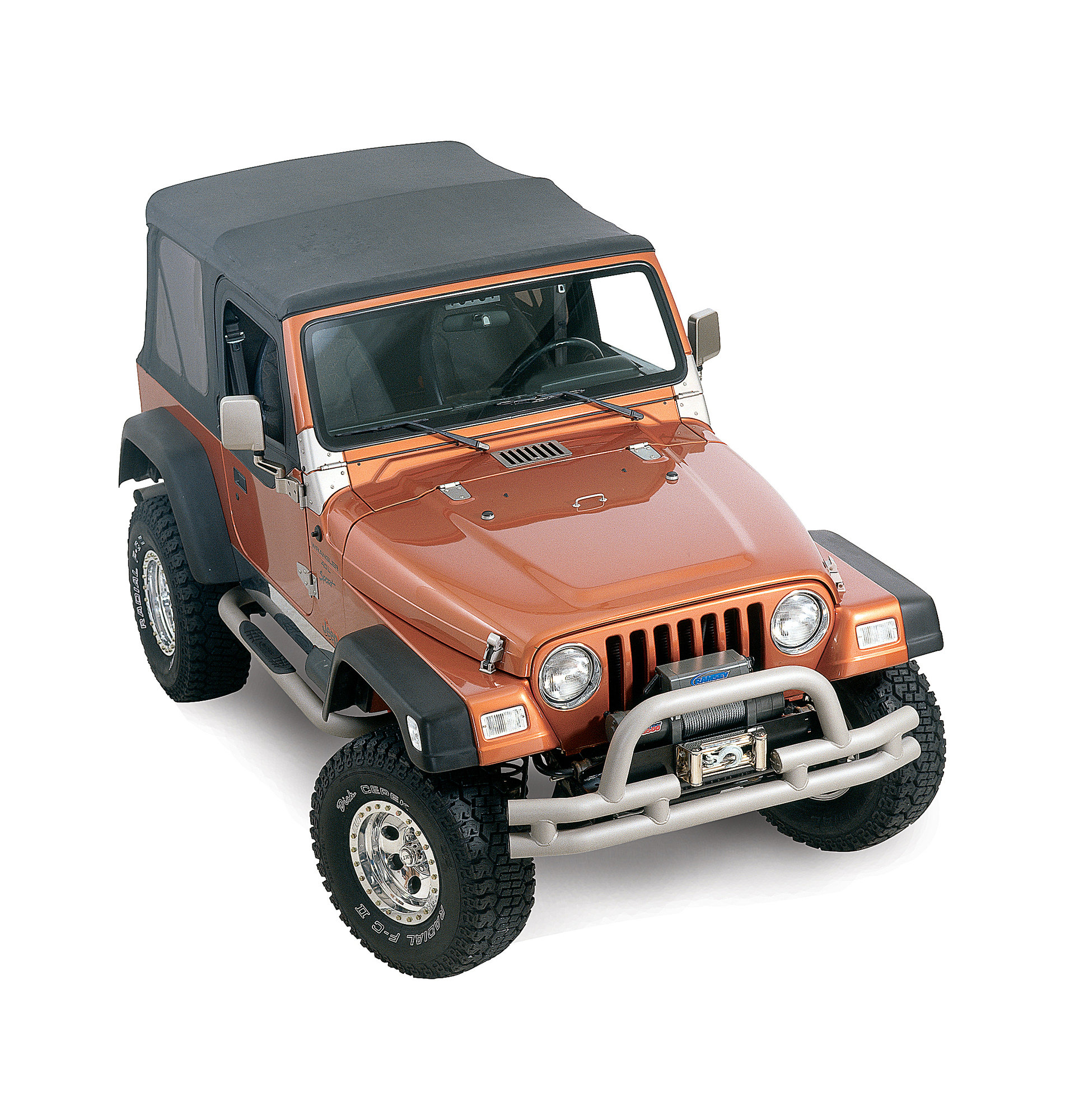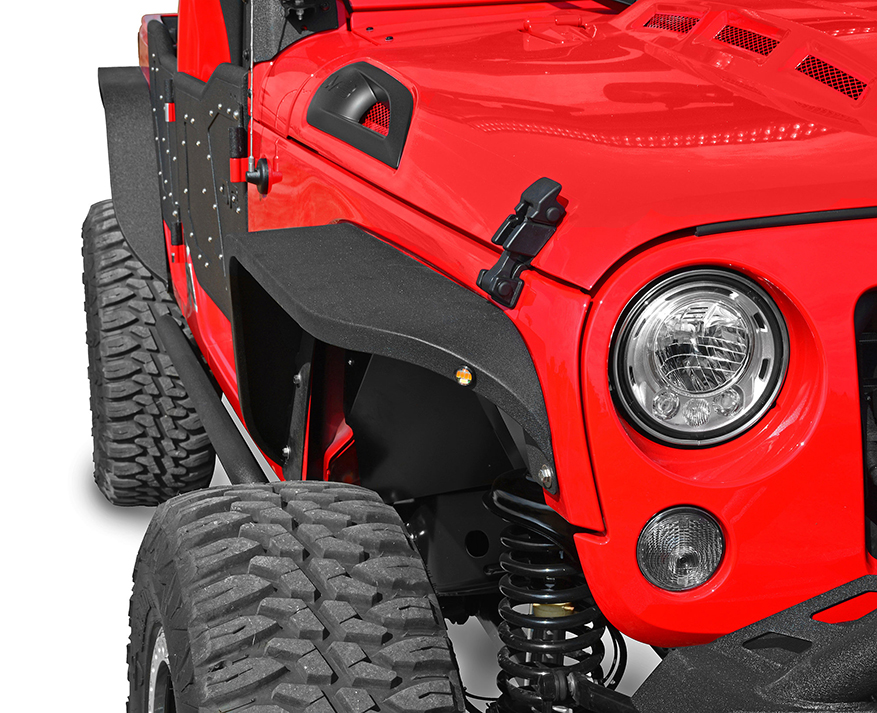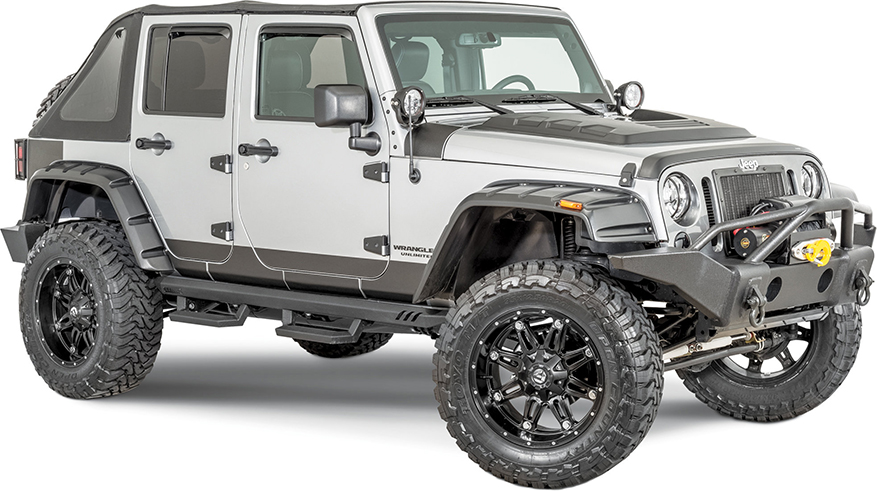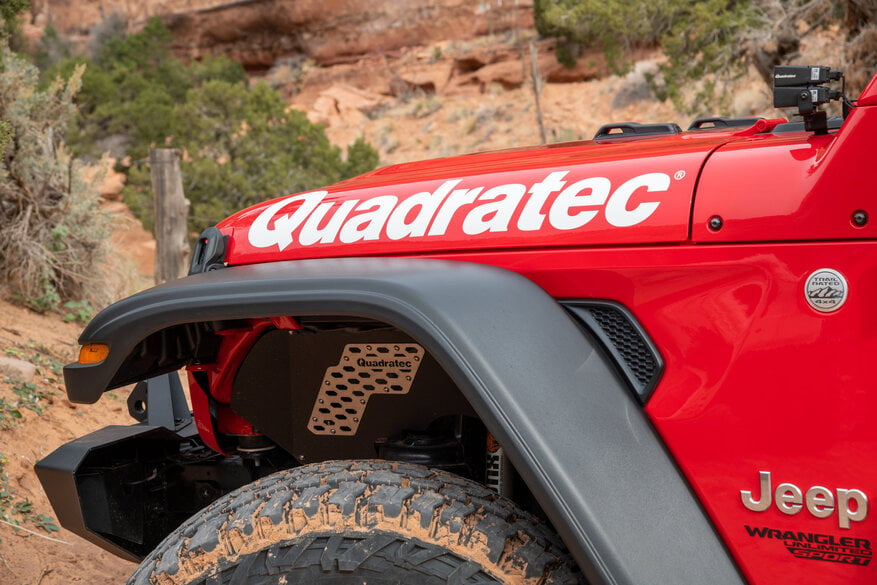by Matt Konkle
Managing Editor
The things sit unassumingly on both sides of your Jeep. Four of them, riding along with you and hanging just over those wheel wells. Sticking out somewhat like a porch awning. And just like that awning protects those underneath from weather or the sun, these metal or plastic pieces jutting from your Jeep’s body also function as an important protective device.
They are called fender flares, and they offer excellent security against a variety of things that can cause problems for yourself or fellow drivers. Stuff like rock chips, mud, grime, dirt, or other road debris spinning off your Jeep’s tires. All problems that can lead to damage on your Jeep’s body, or worse, on someone else’s vehicle. Plus, these flares can absorb most types of impacts in order to protect the Jeep's body.
They are also necessary for another reason as most counties around the country require a fender that covers at least part of the tire’s width, if not all, in order for the vehicle to be considered street legal.
So when it comes time to replace those aging, discolored, or damaged factory flares, there are many available options these days. Perhaps you like the stock flare appearance, and since your vehicle is a daily driver, another design type really doesn’t matter. But, if you are planning on adding larger tires and wider wheels, maybe even a body or suspension lift, then the factory version may not be the best.
That's because when you decide to swap out stock tires for something more aggressive, wider and taller like a solid all-terrain or mud-terrain tire, deep grooves and wide treads on this new rubber can deftly pick up dirt, mud and rocks and sling them anywhere. And the factory flares just can't handle that stuff.
Additionally, depending on the vehicle, when that tire size creeps up past 33- to 35-inches, and a suspension lift kit is installed for additional clearance, those tires tend to stick out further than stock. So, the small-ish factory flares will no longer be adequate to provide protection — especially for those with TJ and older Jeeps. Add in new, more offset wheels, and all this can definitely push those tires outside what many jurisdictions consider legal.
This is why aftermarket fender flares are the perfect compliment for anyone making these types of upgrades. Aftermarket flares can be wider than stock, use more durable materials which hold up under a variety of conditions and give off-road lovers the additional clearance needed for superior tire travel.
All while providing protection and keeping the vehicle street legal.
The majority of these flares fall into five categories; OE style, Flat, High Clearance, Pocket and Tube.

Original Equipment (Factory) Style Flares
OE Style Flares can take two forms. The first is simply a factory-style ABS plastic replacement that offers the same performance, feel, look and coverage as what originally came with the vehicle. This option is for those whose current flares have called it quits, or have become damaged for one reason or another, and all that is needed is to remove the old and add the new.
As far as installation, they fit flush up against the body exactly the same as stock, bolt to all the original factory points and off you go.
For some, though, there are also wider versions of the factory style that still retain the original look right down to the same style opening for the side marker lights.
These wider factory-style flares are mostly for those with older CJ, YJ and TJ vehicles and allow for up to 7” of protective tire coverage that really comes in handy after making that rubber upgrade. Additionally, many of these wider flares are constructed with a more flexible and durable thermoplastic material that is also UV treated to combat sun fade.
Most kits are no-drill applications and mount to the factory locations, however some can require drilling to mount the rear flares.

Flat Flares
This flare design is perhaps the most popular replacement around at the moment and is especially beloved by those who desire additional clearance and better approach angles while working against off-road obstacles. Plus, as they are based on the original Willys Jeep fender design, flat flares add a level of nostalgia and look that demands attention.
It is also a design that oozes strength, customization and longevity as most flat flares are constructed with exceptionally durable, and flexible, UV-treated thermoplastic that come in a variety of widths. They can all flex through a hit without tearing or damaging the vehicle’s body, while also resisting sun fade. In contrast, the ABS plastic on factory flares can deform, or even tear off, from an off-road rock (or tree) strike.
But back to the main feature. Flat flares open up about 2” of additional room in the wheel well for extra tire clearance which definitely comes in handy during more aggressive off-road driving. With the factory flares, tires can often rub against the flare during more severe tire articulation which potentially may lead to flare damage. However, the high clearance of these aftermarket flat flares could put it towards the back of the class when it comes to overall prevention of dirt, mud and rock splatter.
This is where customization is important, and flat flares do come in a variety of sizes from narrow—which can be a nice plus on the trails—to an overall 8” of coverage for additional protection. With these choices, once again, it is important to understand the laws in your area regarding flare tire coverage if you use the vehicle on pavement.
Most flat flares are also no-drill applications that mount to the factory locations, and will either come with a new side marker light or contain brackets to help you relocate the original side markers.

High Clearance Flares
Aftermarket fender flares with a higher clearance have been around for a while, but until recently they were mostly that flat flare design. Don’t get us wrong, those are a cool, nostalgic set up as we said before. But it may not be for everyone.
So for anyone with the latest generation Wrangler JL, there are new high clearance fender flare options that present an excellent way to retain a factory-style appearance to your vehicle, while accommodating larger tires without having to add a suspension lift.
This design is actually a factory set up on the Rubicon edition Wrangler, which gives it that extra space and width to shove up to 37-inch tires under the flare. But those with other models can also join the fun, such as with the Quadratec Baja HD Fender Flares.
The high clearance option means up to three inches of additional clearance over stock flares and about 5/8 inches of extra width — all to give you that clearance you need when off-roading so the tire won’t make contact with the fender or inner fender liner at extreme articulation.
Most high clearance flare options are designed to work with the Wrangler JL’s existing turn signal and daytime running light (DRL) assemblies and can fit with the factory inner liner or most aftermarket versions. These flares are also usually constructed with high-density thermoplastic to increase durability and widthstand most kinds of trail abuse.

Pocket Flares
Pocket Flares resemble the bulkier factory flare appearance, however the extra-wide version of these flares offer more rugged design cues complete with ‘pockets’, or rivets, surrounding numerous additional bolt locations on the flare. This gives the product an eye-catching bold look while presenting a wider vehicle stance and looks good no matter if the vehicle is a daily driver or off-road machine.
The majority of these flares also offer plenty of tire coverage over the factory stock flares, meaning up to 6” for CJ, YJ and TJ, and 11.75” for JK, and are perhaps the best of any flare design at trapping debris coming off the tires and keeping them from striking your Jeep's body, or other vehicles around you. But, because of all this added material, they do not offer much extra space for off-road tire clearance.
If you do take the vehicle off-road, many of these flares can handle what you’ll throw at it thanks to a UV-resistant ABS plastic design that keeps the flares flexible and durable. Additionally, while the numerous extra stainless steel bolts provide that aggressive look, most do not reach the body and the flares attach directly into factory mounting locations, so installation isn't some laborious process. Some older vehicle designs do involve drilling.

Tube Flares
Tube Flares, for the most part, mimic design cues from flat flare versions. However, while flat flares utilize a thermoplastic construction that gives the product flexibility, tubular flares are built with steel or aluminum. Then, a solid tube extends all the way across the flare’s outer edge in order to provide strength and added durability.
Tubular flares are also excellent for those wishing for extra off-road performance as the extra clearance between tire and flare allows for superior tire articulation that won’t rub against the flare.
Another feature that is similar to the flat version is the availability of different sizes from narrow coverage up to 10” wide. Again, if your off-road adventures take you down very tight trails, then the narrow flare design can be helpful, or you can go larger to help protect the body from dirt, mud and road debris—while still getting plenty of tire clearance room.
Keep in mind that, while very durable, these metal flares will not flex against contact. So if your off-road adventures usually involve a lot of scraping and smashing then more flexible flat flares are probably a better solution.
For installation, tubular flares mainly use the factory mounting locations, however, some require a widening of one (or more) of those holes to fit larger hardware and rear flare installation requires pop rivets on some versions.
Related Articles:
Top Five Things Every Jeep Wrangler Owner Should Know
Shop Products In This Article
Top Jeep Articles
- December 18, 2024
- 3 min read
- December 12, 2024
- December 9, 2024
- 5 min read
- December 5, 2024
- 25 min read
- December 4, 2024
- 4 min read
- December 2, 2024
- 8 min read
- November 29, 2024
- 9 min read





















